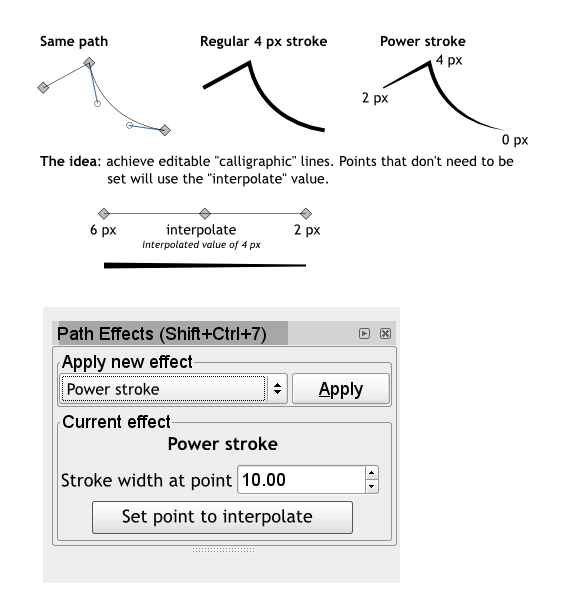Difference between revisions of "PowerStroke"
(New page: = Power stroke = The proposed power stroke LPE is as follow: Image:Power-stroke-1.png == Functionality == This LPE allows a modulated stroke from manually entered values. Further ...) |
Johanengelen (talk | contribs) (→GUI) |
||
| Line 24: | Line 24: | ||
Additionally, hovering over a node could show the value of a node. Graphical feedback could even possibly set different icons for nodes that are set and others that are interpolated. | Additionally, hovering over a node could show the value of a node. Graphical feedback could even possibly set different icons for nodes that are set and others that are interpolated. | ||
== Comments by JohanE == | |||
This is very well doable, but would require a new "Nodepath" implementation that enables writing special values (preferably a struct) per node. There is already something like this, the "nodetypes" attribute, but it is too restrictive. Expanding this would enable this effect, and opens up many other possibilities. Nice idea ! | |||
Revision as of 20:16, 25 March 2008
Power stroke
The proposed power stroke LPE is as follow:
Functionality
This LPE allows a modulated stroke from manually entered values.
Further development could allow direct width reading from a pressure-enabled device.
Workflow
The user simply creates the line, it might for example be based on an outline.
Then the user applies the LPE to his shape, it overrides the normal stroke rendering and allows custom line width at different nodes of the path.
Only the stroke-width property of the path is overridden, the rest of the stroke properties keep working as usual, when relevant.
GUI
Se image above. User selects a nodes or a set of nodes and affects values to those. When a node is selected, you can see what its value is by the change in values in the number entry or by the state of the push button.
Additionally, hovering over a node could show the value of a node. Graphical feedback could even possibly set different icons for nodes that are set and others that are interpolated.
Comments by JohanE
This is very well doable, but would require a new "Nodepath" implementation that enables writing special values (preferably a struct) per node. There is already something like this, the "nodetypes" attribute, but it is too restrictive. Expanding this would enable this effect, and opens up many other possibilities. Nice idea !
